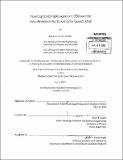Femtosecond fiber lasers at 1550 nm for high repetition rates and low timing jitter
Author(s)
Morse, Jonathan Lee
DownloadFull printable version (28.81Mb)
Other Contributors
Massachusetts Institute of Technology. Department of Electrical Engineering and Computer Science.
Advisor
Erich P. Ippen.
Terms of use
Metadata
Show full item recordAbstract
Femtosecond fiber lasers have become an important enabling technology for advances in many areas including: frequency combs, precise timing distribution, optical arbitrary waveform generation, and high bit rate sampling for analog to digital conversion. Experiments and applications like these put demanding requirements on the source laser oscillator; such as operating near 1550 nm in wavelength, multi-gigahertz repetition rates, sub 100 femtosecond pulse widths, and sub 10 femtosecond timing jitters. This thesis describes the design, fabrication, and characterization of three different iterations of mode-locked laser sources utilizing erbium doped fibers and semiconductor saturable absorbing mirrors to form pulse trains in the 1550 nm wavelength band. The first systems took advantage of a highly doped erbium fiber in a sigma cavity configuration to generate 100 fs pulses at up to a 300 MHz repetition rate through polarization additive pulse mode-locking. At the time, this was the highest fundamental repetition rate to be reported for a fiber cavity in a ring configuration. The next two systems are variations on a linear cavity fiber laser design. In the first, the fiber coupling was achieved through free space optics and the saturable absorbing mirror was also imaged through lenses. Once mode-locked, repetition rates of just beyond 1 GHz were demonstrated with this design; however the laser output was relatively low power. The second version coupled the input and output light through fiber components and coupled the fiber directly to the saturable absorbing mirror. This laser mode-locked in several different states and a study to characterize and understand these states was undertaken. Ultimately, it was understood which conditions minimized the cavity noise and pulse widths thus allowing for the achievement of a 1550 nm, 1 GHz, sub 10 fs jitter, femtosecond fiber laser. This laser is more compact than competing technologies and could be constructed with relatively low cost.
Description
Thesis (Ph. D.)--Massachusetts Institute of Technology, Dept. of Electrical Engineering and Computer Science, 2013. Cataloged from PDF version of thesis. Includes bibliographical references.
Date issued
2013Department
Massachusetts Institute of Technology. Department of Electrical Engineering and Computer SciencePublisher
Massachusetts Institute of Technology
Keywords
Electrical Engineering and Computer Science.